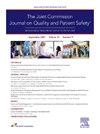The DRIP Criteria: Reducing the Frequency of Peripheral Intravenous Catheter Insertion in Hospitalized Patients
IF 2.4
Q2 HEALTH CARE SCIENCES & SERVICES
Joint Commission journal on quality and patient safety
Pub Date : 2025-06-29
DOI:10.1016/j.jcjq.2025.06.012
引用次数: 0
Abstract
Background
Patient harm attributed to invasive devices is a global concern. Around 18% to 54% of all catheter-related hospital-acquired bloodstream infections (HABSIs) are attributable to peripheral intravenous cannulas (PIVCs). Between 4% and 28% of PIVCs placed in hospitalized patients and up to 50% of emergency department (ED) PIVCs are not used. Avoiding insertion of the “just in case” PIVC where safe to do so has potential to reduce patient risk.
Tool Development
The DRIP mnemonic (Deterioration, Rehydration, Intravenous medications, Procedure) was designed around four simple questions to guide clinicians’ decision-making relating to PIVC insertion. DRIP can also be used to support the daily review of existing cannulas to confirm ongoing need. Both applications align to daily workflows to promote a culture of safety.
Results
DRIP has assisted in reducing the number of idle PIVCs reported in monthly quality and safety audits from 8.3% to 1.8%. Removal of these PIVCs was possible after confirmation with treating teams that the device was not clinically indicated. This has reduced patient exposure to HABSI. During a 15-month period, independent assessment of PIVC insertion requests by the Vascular Access Team found that 3,103 PIVC requests (10.1%) were deemed not clinically indicated and were not inserted. None met DRIP criteria, which suggests independent expert clinician assessment aligns well to the DRIP criteria in practice.
Conclusion
DRIP has shown that elimination of cannulation where not clinically indicated is achievable. Use of the DRIP tool can support safe organizational culture by encouraging staff to question the need for a PIVC to reduce or eliminate the “just in case” or idle cannula. Formal validation of DRIP across multiple settings would strengthen the evidence base underpinning PIVC decision-making.
DRIP标准:减少住院患者外周静脉置管的频率。
背景:侵入性器械对患者的伤害是一个全球关注的问题。在所有导管相关的医院获得性血流感染(habsi)中,约18%至54%可归因于外周静脉插管(pivc)。在住院患者中放置的pivc中有4%至28%没有使用,在急诊科(ED)放置的pivc中有高达50%没有使用。在安全的情况下避免插入“以防万一”的PIVC有可能降低患者的风险。工具开发:DRIP助记器(恶化,补液,静脉注射药物,程序)围绕四个简单的问题设计,以指导临床医生与PIVC插入相关的决策。DRIP还可用于支持对现有套管的日常审查,以确认持续的需求。这两个应用程序都与日常工作流程保持一致,以促进安全文化。结果:DRIP帮助将每月质量和安全审计中报告的闲置pivc数量从8.3%减少到1.8%。在治疗团队确认该装置无临床指征后,可以移除这些pivc。这减少了患者对HABSI的暴露。在15个月的时间里,血管准入小组对PIVC插入请求的独立评估发现,3103个PIVC请求(10.1%)被认为没有临床指征,没有插入。没有人符合DRIP标准,这表明独立专家临床医生的评估在实践中与DRIP标准非常一致。结论:DRIP已经表明,消除无临床指征的插管是可以实现的。使用DRIP工具可以通过鼓励员工质疑是否需要PIVC来减少或消除“以防万一”或闲置的套管,从而支持安全的组织文化。跨多种设置的DRIP正式验证将加强支持PIVC决策的证据基础。
本文章由计算机程序翻译,如有差异,请以英文原文为准。
求助全文
约1分钟内获得全文
求助全文
来源期刊

Joint Commission journal on quality and patient safety
HEALTH CARE SCIENCES & SERVICES-
CiteScore
3.80
自引率
4.30%
发文量
116
审稿时长
49 days
 求助内容:
求助内容: 应助结果提醒方式:
应助结果提醒方式:


